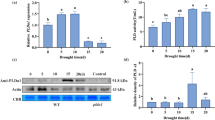Abstract
Kalanchoe blossfeldiana plants grown under long days (16 h light) exhibit a C3-type photosynthetic metabolism. Switching to short days (9 h light) leads to a gradual development of Crassulacean acid metabolism (CAM). Under the latter conditions, dark CO2 fixation produces large amounts of malate. During the first hours of the day, malate is rapidly decarboxylated into pyruvate through the action of a cytosolic NADP+-or a mitochondrial NAD+-dependent malic enzyme. Mitochondria were isolated from leaves of plants grown under long days or after treatment by an increasing number of short days. Tricarboxylic acid cycle intermediates as well as exogenous NADH and NADPH were readily oxidized by mitochondria isolated from the two types of plants. Glycine, known to be oxidized by C3-plant mitochondria, was still oxidized after CAM establishment. The experiments showed a marked parallelism in the increase of CAM level and the increase in substrate-oxidation capacity of the isolated mitochondria, particularly the capacity to oxidize malate in the presence of cyanide. These simultaneous variations in CAM level and in mitochondrial properties indicate that the mitochondrial NAD+-malic enzyme could account at least for a part of the oxidation of malate. The studies of whole-leaf respiration establish that mitochondria are implicated in malate degradation in vivo. Moreover, an increase in cyanide resistance of the leaf respiration has been observed during the first daylight hours, when malate was oxidized to pyruvate by cytosolic and mitochondrial malic enzymes.
Similar content being viewed by others
Abbreviations
- CAM:
-
Crassulacean acid metabolism
- MDH:
-
malate dehydrogenase
- ME:
-
malic enzyme
References
Arron, G.P., Spalding, M.H., Edwards, G.E. (1979) Isolation and oxidative properties of intact mitochondria from the leaves of Sedum praeltum. Plant Physiol. 64, 182–186
Day, D.A. (1980) Malate decarboxylation by Kalanchoë daigremontiana mitochondria and its role in Crassulacean acid metabolism. Plant Physiol. 65, 675–679
Day, D.A., Arron, G.P., Laties, G.G. (1980) Nature and control of respiratory pathways in plants: The interaction of cyanide-resistant pathway. In: The biochemistry of plans, vol 2, pp. 581–611, Davies, D.D., ed. Academic Press, New York London
Dittrich, P. (1976) Nicotinamide adenine dinucleotide specific “malic” enzyme in Kalanchoë daigremontiana and other plants exhibiting Crassulacean acid metabolism. Plant Physiol. 57, 310–314
Hampp, R., Goller, M., Ziegler, H. (1982) Adenylate levels, energy charge, and phosphorylation potential during dark-light and light-dark transition in chloroplasts, mitochondria, and cytosol of mesophyll protoplasts from Avena sativa L. Plant Physiol. 69, 448–455
Kinraide, T.B., Marek, L.F. (1980) Wounding stimulates cyanide-sensitive respiration in the highly cyanide-resistant leaves of Bryophyllum tubiflorum Harv. Plant Physiol. 65, 409–410
Lance, C., Rustin, P. (1984) The central role of malate in plant metabolism. Physiol. Vég. 22, 625–641
Laties, G.G. (1982) The cyanide-resistant, alternative path in higher plant respiration. Annu. Rev. Plant Physiol. 33, 519–555
Lilley, R.McC., Fitzgerald, M.P., Rienits, K.G., Walker, D.A. (1975) Criteria of intactness and the photosynthetic activity of spinach chloroplast preparations. New Phytol. 75, 1–10
McKinney, G. (1941) Absorption of light by chlorophyll solutions. J. Biol. Chem. 140, 315–322
Morel, C., Queiroz, O. (1978) Dawn signal as a rhythmical timer for the seasonal adaptive variation of CAM: a model. Plant Cell Environ. 1, 141–149
Neuburger, M., Douce, R. (1977) Oxydation du malate, du NADH et de la glycine par les mitochondries des plantes en C3 et C4. C. R. Acad. Sci., ser. D, 285, 881–884
Neuburger, M., Douce, R. (1978) Transport of NAD+ through the inner membrane of plant mitochondria. In: Plant mitochondria, pp. 109–116, Ducet, G., Lance, C., eds. Elsevier/North-Holland Biomedical Press, Amsterdam
Palmer, J.M., Schwitzguébel, J.P., Møller, I. (1982) Regulation of malate oxidation in plant mitochondria. Response to rotenone and exogenous NAD+. Biochem. J. 208, 703–711
Queiroz, O. (1974) Circadian rhythms and metabolic patterns. Annu. Rev. Plant Physiol. 25, 115–134
Ranson, S.L., Thomas, M. (1960) Crassulacean acid metabolism. Annu. Rev. Plant Physiol. 11, 81–110
Robbie, W.A. (1948) Use of cyanide in tissue respiration studies. Methods Med. Res. 1, 307–316
Rustin, P., Moreau, F., Lance, C. (1980) Malate oxidation in plant mitochondria via malic enzyme and the cyanide-insensitive electron transport pathway. Plant Physiol. 66, 457–463
Rustin, P., Dupont, J., Lance, C. (1983) Oxidative interactions between fatty acid peroxy radicals and quinones: possible involvement in cyanide-resistant electron transport in plant mitochondria. Arch. Biochem. Biophys. 225, 630–639
Rustin, P., Lance, C. (1983) Possible regulation of mitochondrial activity in the cellular context of CAM plant leaves. In: International symposium on membranes and compartmentation in regulation of plant functions, Abstract 40, Phytochem. Soc. Eur.
Rustin, P., Dupont, J., Lance, C. (1984) Involvement of lipid peroxy radicals in the cyanide-resistant electron transport pathway. Physiol. Vég. 22, 643–663
Stitt, M., Lilley, R. McC., Heldt, H.W. (1982) Adenine nucleotide levels in the cytosol, chloroplasts, and mitochondria of wheat leaf protoplasts. Plant Physiol. 70, 971–977
Tobin, A., Djerdjour, B., Journet, E., Neuburger, M., Douce, R. (1980) Effect of NAD+ on malate oxidation in intact plant mitochondria. Plant Physiol. 66, 225–229
Tolbert, N.E. (1974) Isolation of sub-cellular organelles of metabolism on isopycnic sucrose gradients. Methods Enzymol. 31, 734–746
Turner, J.F., Turner, D.H. (1975) The regulation of carbohydrate metabolism. Annu. Rev. Plant Physiol. 26. 159–186
Von Willert, D.J., Schwöbel, H. (1978) Changes in substrate oxidation during development of a Crassulacean Acid Metabolism. In: Plant mitochondria, pp. 403–410, Ducet, G., Lance, C., eds. Elsevier/North-Holland Biomedical Press, Amsterdam
Walker, D.A. (1960) Physiological studies on acid metabolism. VII. Malic enzyme from Kalanchoe crenata: effects of carbon dioxide concentration. Biochem. J. 74, 216–223
Author information
Authors and Affiliations
Rights and permissions
About this article
Cite this article
Rustin, P., Queiroz-Claret, C. Changes in oxidative properties of Kalanchoe blossfeldiana leaf mitochondria during development of Crassulacean acid metabolism. Planta 164, 415–422 (1985). https://doi.org/10.1007/BF00402955
Received:
Accepted:
Issue Date:
DOI: https://doi.org/10.1007/BF00402955




